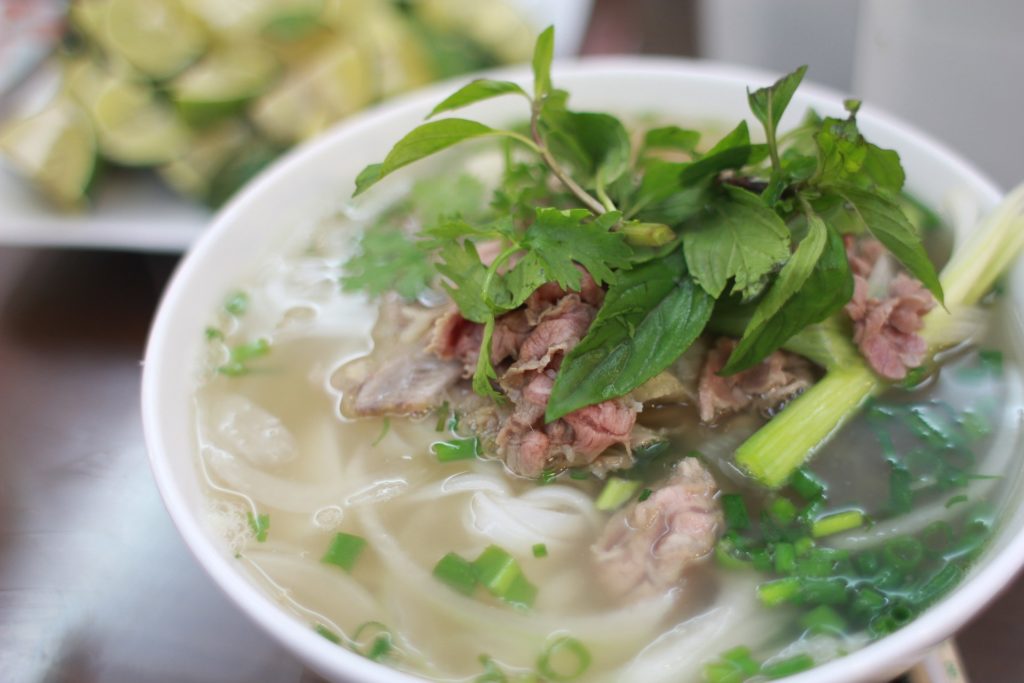Basic Ingredients in Vietnamese Cuisine Posted by Kandle Dart on Apr 5, 2021 in Culture, Foods, Vocabulary
Vietnamese food is considered one of the healthiest cuisines in the world in my opinion. Maybe I’m biased, since I am Vietnamese, but with a lot of fresh ingredients; herbs, and vegetables in every traditional dish, this diet is pretty low in calories but very flavorful and tasty.
If you have to pick what basic ingredients to use daily in the basic dishes, you can’t go wrong with these essential ingredients:
- Nước mắm (fish sauce)
- Tiêu (pepper)
- Tỏi (garlic)
- Hành lá (green onion)
- Ngò (cilandro)
- Ớt (chili pepper)
Nước mắm (fish sauce)
Nước mắm is the soul of Vietnamese cuisine. Nuoc mam is a very salty liquid condiment made from small fish that have been layered with salt in a chum (large jar) and fermented for an average of one year. You will find at least a bottle, if not a gallon, in every Vietnamese household’s kitchen. Besides its use as a staple seasoning in food, it’s also commonly served as a nước chấm (dipping sauce). Indeed, you would find a small bowl of nước mắm on the table with every Vietnamese main meal.
Gia vị (spice/seasoning):
Of course, the Vietnamese use different spices in different dishes, but the most common one is always tiêu trắng (white pepper). A pinch of ground pepper is often added when marinating seafood or meats. A pinch of ground pepper can be added at the end to enhance the flavor in soup, stir fry vegetables, etc. Other popular spices include quế (cinnamon) and hồi (star anise).
Rau thơm (fragrant herbs)
Rau thơm is essential in every dish and differentiate Vietnamese food from other world cuisines. Most importantly, Vietnamese use them fresh, not dried. I can’t recall if there are any meals without the presence of fresh herbs. It doesn’t matter whether it’s a dish or salad, fried rice, porridge, or noodles, they are all garnished with at least one fresh herb such as cilantro. Green onion is also present in all noodle dishes. Soup broths often call for ginger, lemongrass, onion, and other herbs and vegetables. Húng quế (basil) is a must to add to the bowl of phở (traditional rice noodle soup) when served to bring up its flavor.
There is a popular folk poem that teaches what herb goes well with which dish:
“Con gà cục tác lá chanh
Con lợn ủn ỉn mua hành cho tôi
Con chó khóc đứng khóc ngồi
Mẹ ơi đi chợ mua tôi đồng riềng.”
Translation:
The chicken clucks, get me a lime leaf.
The pig oinks, buy me an onion.
The dog is crying begging, said
Mother please, buy me a piece of galangal.
So, lime leaf goes well with the steamed chicken dish (gà hấp). Onion or scallion is a must in any pork dish. Galangal is required in dog meat dishes (chả cầy). I know you’re probably raising your eyebrows hearing the word “dog meat”. Unfortunately, it’s still legal to consume as a delicacy street dish, mostly favored by men, and served as a side dish while drinking rượu đế (rice wine). Fortunately, there is an invention of giả cầy, an imitation, vegetarian dog meat dish that is more widely popular with the general population.
Growing up having fresh herbs everyday in my diet, I’m so used to the smell of them. Even with my closed eyes, I could tell what herb is that from its scent. I love fresh herbs and believe they are the secret ingredients in our cuisine that make it different from others in the world.

Build vocabulary, practice pronunciation, and more with Transparent Language Online. Available anytime, anywhere, on any device.




